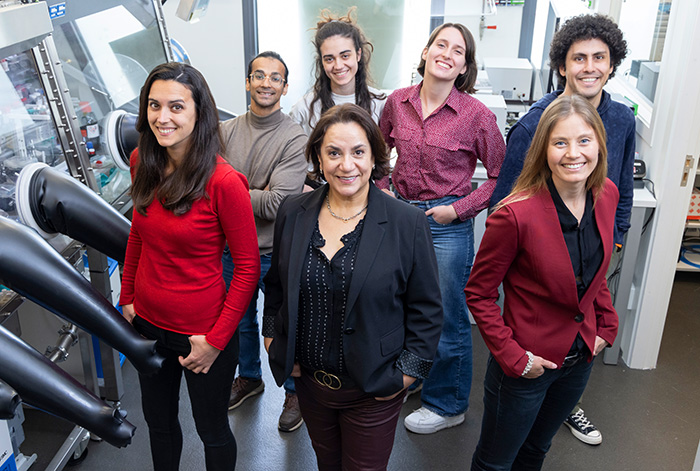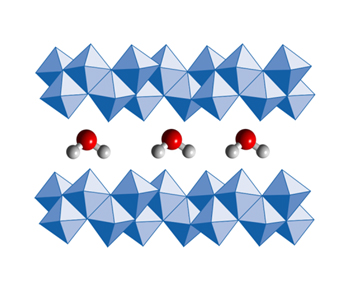Nanostructured Materials for Photovoltaic Energy
Group Leader: Mónica Lira-Cantú

Main Research Lines
Photovoltaics: next-generation thin film, organic, hybrid, dye-sensitised, halide perovskite and all-oxide solar cells
Synthesis of nanomaterials by low-cost, low-temperature and green solution processing methods
Solution processing methods for the fabrication of solar cells and printed electronics
Degradation studies of the stability of solar cells following ISOS protocols
Semiconductor oxides for energy, ICT applications and printed electronics
Self-powered transparent, flexible electronic and optoelectronic devices

The NMPE group research objectives are focused on the synthesis of novel nanomaterials and the control of their optoelectronic properties through their manipulation at molecular level, with the aim of developing highly stable and highly efficient perovskite solar cells. Specifically, our contribution is in the area of solution processable metal oxides (classical and complex), halide perovskites (Pb-free, 2D and 3D) and, more recently, 2D materials and MXenes. We aim at the development of highly stable solar cells for industrial applications (e.g. building integration PV) and novel self-powered photovoltaic-based devices for Internet of things (IoT) applications (e.g. sensors, wearables, printed electronics). The group, with more than 15 year of experience in the field, is internationally recognized for its involvement in the enhancement of the operational stability of emerging photovoltaics and the development of ISOS protocols.
Fundamental Research Lines: Various of our lines of study are related to highly innovative and fundamental research within technology readiness levels (TRLs) below 2. We aim at the synthesis of materials as absorbers, transport layers and interfaces in solar cells. This line includes the synthesis of novel materials such as Pb-free halide perovskites, 2D materials and halide perovskites, novel anti-perovskites. More recently, we have initiated the development of novel MXenes and 2D materials. One of the objectives of this research is the manipulation of materials properties to enhance solar cells stability and the understanding of the mechanisms that permit their stability. We focus on the study and passivation of point defects of materials and interfaces.
Another major goal of the group is the synthesis of nanostructured materials, especially those involving transition metal oxides (TMOs), via the application of low-cost and solution processing methods. They have many possible applications as main active materials or barrier layers, but also as materials for external light management. The use of low-temperature synthesis methods (sol gel, hydrothermal, SILAR, among many others) permits tuning and controlling the properties of the final device. These oxides are being applied in our group as nanostructured materials (nanorods, nanowires, nanotrees, core-shell, etc.) and dense thin films in the various next-generation solar cells, offering excellent performance in term of efficiency and lifetime. We are now functionalising these oxide surfaces by anchoring self-assembled monolayers with selected anchoring groups to interact simultaneously with the oxide and the active light harvesting material.
Applied Research Lines: Our applied research lines are dedicated to the development of novel and innovative devices whose technology readiness levels (TRLs) can be up to 7. We are working on high-efficiency perovskite solar cells and novel printed electronic devices, which can allow the group to collaborate with industry and to obtain intellectual property rights. We are also collaborating with top laboratories for the development of protocols and standards, which can help the perovskite solar cell technology to reach the market.
The group also works on the development of self-powered electronic and optoelectronic devices, as well as flexible and transparent devices for ICT and electronic applications.
Group Leader

Mónica Lira-Cantú
CSIC Research Scientist
monica.lira@icn2.cat
After completing a Bachelor’s degree in Chemistry in 1992, Prof. Monica Lira-Cantu obtained her Master’s and PhD degrees in Materials Science at the Institut de Ciència de Materials de Barcelona (ICMAB) and the Universitat Autònoma de Barcelona in 1995 and 1997, respectively. She worked as a postdoctoral fellow for Schneider Electric and ICMAB until 1998. From 1999 to 2001 she was a permanent senior staff chemist at ExxonMobil Research & Engineering (formerly Mobil Technology Co) in New Jersey (USA), establishing a group on energy-related applications.
Dr Lira-Cantu has received various awards, as well as visiting scientist fellowships at the following laboratories: Universitetet i Oslo (Norway) (ESF, 2003), RisDTU Nationallaboratoriet (Denmark) (AGAUR, 2004/05), and Center for Advanced Science and Innovation (Osaka University, Japan) (Canon Foundation in Europe, 2006). She is group leader of the Nanostructured Materials for Photovoltaic Energy since 2006. She obtained a tenured track position at Consejo Superior de Investigaciones Cientificas (CSIC) in 2007, and she was promoted to Scientific Researcher in 2017 and Full Professor in 2022.
She is currently an evaluator for the European Commission for the ERC Starting, Consolidator and Advanced grants. She has coordinated and organised more than 24 scientific conferences and is scientific referee for more than 20 international and European research agencies, and more than 50 scientific journals. Prof. Lira-Cantu is a member of the editorial board of SN Applied Science (Nature). She is Editor-in-Chief of APL Energy (AIP Publishing) and Advisory Editorial Board for Discovery Materials and Springer Nature Applied Sciences (Nature); Adv. Energy and Sustainability (Wiley); Chemical Physics Impact (Elsevier) and Matter (Cell Press). Since 2016 she has been a member of the local and national advisory board for the Nanotechnology and Chemical Science degree (INCQ) of the Instituto Tecnológico y de Estudios Superiores de Monterrey (ITESM, Mexico).
The research interests of Prof. Lira-Cantu lie in the synthesis and application of nanostructured materials for highly efficient and high stable next-generation thin-film solar cells: halide-perovskite, dye-sensitised, alloxide and organic solar cells. Her group has developed halide perovskite solar cells with efficiencies above 23 % and 1000 h stability under continuous illumination. The group also focuses on applying solar cells in printed batteryless, self-powered electronics for the IoT (on flexible, transparent and/or smart materials). In-situ and operando characterization applying Raman, X-ray diffraction, Photooluminiscece and Impedance spectroscopy, is also a research field under her direction.
Since 2007 she has been the PI of several projects (national, European and with industry), for example, she was the coordinator of a COST Action Project (StableNextSol MP1307) related to the study of the stability of Organic and Perovskite solar cells. The project had more than 450 members from 35 countries and 22 companies. It was highlighted four times in the SETIS and European Energy Innovation Magazine, and selected as a Success Story by the European Commission.
She has directed more than 90 members in her group: 1 Visiting professor, 1 ICREA Jr Group Leader, 1 Jr Group Leader “La Caixa” incoming, 2 project Managers, 8 Postdocs, 1 Beatriu de Pinos Postdoc, >10 PhDs (4 in course) and > 70 undergraduate students: Master, Bachelors and short term visiting students. Prof. Monica Lira-Cantu has more than 135 scientific publications, among them more than 125 journal articles, 1 edited book, 10 book chapters, 11 patents. According to Google Scholar, she has over 10,000 citations overall and an H index of 52.

